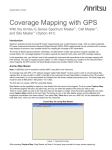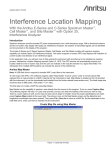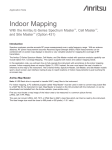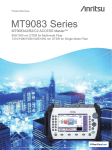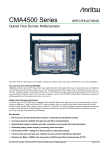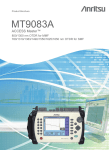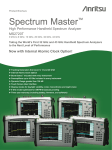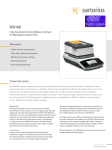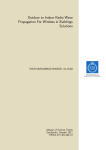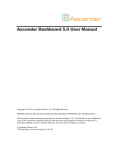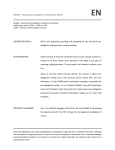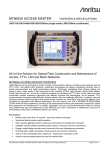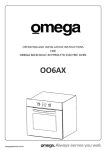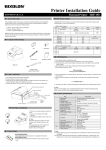Download MS27102A Remote Spectrum Monitor Product Brochure
Transcript
Product Brochure MS27102A Remote Spectrum Monitor MS27102A Remote Spectrum Monitor Introduction With the rapid expansion of wireless communications, the need for robust networks relatively free of interference continues to grow. Capacity will be degraded by the presence of illegal or unlicensed signals that interfere with needed transmissions. These signals can be periodic or present at different frequencies over time, making the discovery and removal of these sources of interference a significant challenge. A spectrum monitoring system will facilitate the identification and removal of illegal or unlicensed interference signals. By monitoring spectrum on a continual basis, problem signals can be identified as they occur in real time. Patterns of unwanted signal activity can also be examined, providing an efficient way to characterize and locate the source of the interference problem. In addition to interference detection, spectrum monitoring is also used to characterize spectrum occupancy. Government regulators and operators are often interested in determining the usage rate for various frequency bands. Monitoring these frequencies provides the information needed to optimize spectrum for maximum utilization. Spectrum can be re-purposed for other applications or multiplexed with other signals using cognitive radio techniques. Spectrum monitoring can also serve to enforce compliance with government regulations. Police, fire fighters, air traffic control, military and emergency services must all have access to communications free of impediments and distortion. Compliance with spectrum regulations is often enforced by spectrum monitoring. Figure 1 shows the MS27102A deployed to monitor Positive Train Control (PTC) frequencies. PTC is being deployed worldwide to provide automated signaling for train control. The MS27103A can also be used inside the train to insure wireless integrity. Computer-aided Dispatching & Back Office Server Systems Communication Network Component Base Station Database Location Reports Signal Status Anritsu Rack Mount Spectrum Monitor MS27102A Wayside Signal Station Onboard System Figure 1: Spectrum Monitoring System monitoring PTC frequencies 2 MS27102A Remote Spectrum Monitor MS27102A Remote Spectrum Monitor Capable of sweeping at rates up to 24 GHz/s, the MS27102A allows capture of many types of signals. This includes periodic or transient transmissions as well as short “bursty” signals. Also featured is a high dynamic range, high sensitivity and low spurious signals. This enables the MS27102A ( shown here in Fig 2) to reliably distinguish between low-level signals being observed and those signals generated by the monitor itself. Figure 2: MS27102A Outdoor Spectrum Monitor (IP67) Key facts • 9 kHz to 6 GHz • Integrated GPS receiver for monitoring location and for time synchronization applications • Sweep speed up to 24 GHz/s • Gigabit Ethernet available for high speed transmissions • Integrated web server to view, control and conduct measurements via a web browser (both Chrome and FireFox supported) • Interference analysis: spectrogram and signal strength • Remote firmware update capable • Dynamic range: > 106 dB normalized to 1 Hz BW • Watchdog timer to insure long-term stability for remotely deployed monitors • DANL: <–150 dBm referenced to 1 Hz BW, preamp On • IP67 rated for outdoor deployments • Phase noise: –99 dBc/Hz @ 10 kHz offset at 1 GHz • Linux operating system • IQ block mode and streaming with time stamping for TDOA applications • Low spurious signals for accurate signal discovery • 20 MHz instantaneous FFT bandwidth • VisionTM software optional for automated spectrum measurements, setting alarms and geo-locating signal sources • Low power consumption < 11 watts (input voltage 11 to 24 VDC) 3 MS27102A Remote Spectrum Monitor Designed For Remote Applications With monitors potentially being deployed hundreds or thousands of kilometers from the control center, it is imperative that each probe remain operational under all types of conditions. The MS27102A is designed for robust field deployments, with capabilities for remote power cycling, automated system recovery protocols and firmware updates “pushed” to the monitor remotely. In the event of an application error or power fluctuation which causes an ongoing interruption in monitor communication, a re-boot policy is implemented to bring the remote probe back to its previous state. Under these conditions, the current firmware is automatically reloaded and on-line operation is restored. Instrument settings are also restored to their previous state. A “Golden” firmware image is also placed on each unit in a secure location in memory. If for any reason the firmware in the unit becomes corrupted, a Golden Image is used to bring back full operation of the probe. This feature is particularly useful for remote firmware updates. Figure 3: MS27102A Outdoor Spectrum Monitoring System Remote Firmware Updates There are several stages or “checks” performed when a new firmware package is downloaded remotely into the instrument. Once a new firmware image is downloaded to the monitor, various tests are performed to insure the code was properly transmitted without error (see Fig 4). The code is then transferred into probe memory and installed. If a failure occurs during firmware acquisition or validation, the process is aborted and the failure status is returned to the user. If the firmware update is installed but does not operate correctly, the Golden Image automatically replaces the downloaded firmware to keep the remote monitor operational. The Golden Image feature provides the user with assurance that the monitor stays in operation when changes are made to the code. Any bug fixes, updates or user requested features can then be remotely sent to the spectrum monitor and safely incorporated. Validate Firmware Validation Error? Do Not Update Boot Normal Image Application Error? Boot Golden Image Figure 4: Firmware Update Policy 4 MS27102A Remote Spectrum Monitor Integrated Web Server The MS27102A features an integrated web server. Using an internet browser (Chrome and FireFox are supported), a user from anywhere in the world can log in to the spectrum monitor and control any of its features. This includes such parameters as frequency settings, RBW/VBW control, reference level configuration and many other settings relevant to the user’s spectrum monitoring application. Trace data, spectrograms and other measurements can be viewed inside the browser window. A key advantage in using the web server is that it is platform agnostic. Any electronic device capable of rendering a browser will work with the web server. Users can utilize their PC/ laptop, tablet or even a smartphone to view the spectrum and change instrument settings. The MS27102A features Gbit Ethernet, allowing fast transfers of measurement data and control information. Figure 5 shows the server application displayed on a smartphone. Figure 5: User interface displayed on smartphone See figure 6 below for the main user interface provided by the web server. Figure 6. Screenshot of user interface 5 MS27102A Remote Spectrum Monitor Hardware The MS27102A is rated to IP67 standards for outdoor deployment. It is dust tight (no ingress of dust) as well as water resistant. This involves testing the probe for immersion into as much as 1 meter of water for durations of up to 30 minutes. Each port on the unit is ruggedized and weatherized. Ports include power, RF Input, Gbit Ethernet and GPS antenna. See figure 7 for port positioning. With an operating temperature range from –40 ⁰C to +55 ⁰C, a rugged weatherized case and splash proof design, the MS27102A works in the most extreme weather conditions with guaranteed performance anywhere and anytime. GPS No Connect Power Ethernet RF In Port 2 RF In Port 1 Figure 7. Port locations on MS27102A (2-port option shown) The MS27102A comes with a mounting plate designed for field applications. With user supplied U-Bolts or clamps, the mounting plate allows the monitor to be mounted on poles of varying diameters. Instructions for mounting your spectrum monitor can be found on the Anritsu website. The probe uses power from a 11 VDC to 24 VDC source, typically consuming less than 11 Watts. The low power consumed facilitates the use of the spectrum monitor powered from solar cells. 6 MS27102A Remote Spectrum Monitor Key Applications • Radio surveillance and monitoring • Detection of illegal or unlicensed transmitters, including AM/FM and cellular broadcasts • Coverage measurements • Spectrum occupancy and frequency band clearing • Fast and efficient detection and elimination of interference sources • Monitor jails/prisons for illegal broadcasts • Security at military facilities, national borders, utilities, airports and other sensitive sites (see fig. 8) • Spectrum monitoring associated with lab RF testing • Government regulators enforcing spectrum policies Fig 8: Anritsu remote spectrum monitor positioned at airport Signals of Interest The wide variety of signals to be monitored fall into several categories. Each of these types of signals will be examined in some detail. These include: • Intentional interference (including illegal or unlicensed broadcasts) • Accidental interference • Occupancy Intentional Interference Illegal AM/FM and video broadcasts are found in many parts of the world. These signals can be generated by pirated broadcast equipment or by using over-powered CB radios. Figure 9 shows a table listing interference complaints per year registered by the UK government communications regulator Ofcom. In YEAR INTERFERENCE COMPLIANTS this table, ‘Critical service’ refers to interference reports affecting life services communications. Critical service All other Additionally, jammers are sometimes used for applications such as preventing students from cheating on tests, stopping employees from taking phone calls on company time or to prevent inmates from making illicit calls from prisons. Jammer signals can often leak out into the wider environment, interfering with other legitimate services. Mitigating these types of interference has become a high priority with government regulators. London Rest of UK London Rest of UK 1010 29 4 506 72 2011 35 0 424 69 2012 36 2 288 48 2013 21 5 179 93 Fig 9: Interference complaints published by Ofcom, communications regulator in the UK 7 MS27102A Remote Spectrum Monitor Accidental Interference A wide variety of accidental interference can be seen in the spectrum. A common problem is cable TV leakage. This type of leakage exists both from cable signals leaking into the outside environment as well as from external signals leaking into the cable system. This problem has been enhanced with the transmission of cable signals into frequency bands used by broadcasters and cellular operations (such as the 700 MHz LTE band). DECT phones also cause interference problems, particularly when people bring their wireless phones along when moving from one country to another. DECT frequencies vary in different countries, providing the potential for interference when transported. Figure 10 below shows spectrum used in the U.S. for certain cellular frequencies. DECT phones brought by travelers from other countries can often cause interference. BRAZIL DECT JAPAN DECT EUROPE DECT A2 A3 D B1 B2 B3 E F C1 C2 NA DECT C3 A1 A3 D B1 B2 B3 E F C1 C2 C3 1930 MHz 1920 MHz 1910 MHz North America PCS Uplink 1900 MHz 1890 MHz 1880 MHz 1850 MHz North America PCS Uplink A2 1990 MHz A1 LATIN AMERICA CHINA DECT (Pre 2003) Figure 10: DECT phones improperly used can cause unintentional interference Other sources of interference include cellular signals (due to antenna tilt or azimuth errors), repeaters oscillating, wireless microphone problems, power equipment and many others. Occupancy With the rapid demand for available spectrum from both public and private sectors, new ways are being investigated to allow more efficient use of various frequency bands. A lot of the spectrum is potentially underutilized, providing the opportunity to re-purpose existing spectrum with additional Radio band 400-470 MHz applications. TV Band IV & V, 470-830 (862) MHz Spectrum occupancy measurements quantify the amount of usage of frequency bands over a given period of time (see figure 11). Remote spectrum probes are used to monitor a band of frequencies, recording spectral histories as a function of time. GSM 900, 880 (888)-915 MHz, 925 (933)-960 MHz Radio band 960-1710 MHz GSM 1800, 1710-1785 MHz, 1805-1880 MHz DECT, 1880-1900 MHz UMTS, 1900-2025 MHz, 2110-2200 MHz ISM, 2.4-2.5 GHz Radio band 400 MHz-3 GHz Radio band 400 MHz-6 GHz City A City B City C 0 20 40 Spectrum Utilization [%] Figure 11: Spectrum occupancy measurement 8 MS27102A Remote Spectrum Monitor Performance The MS27102A is able to sweep the frequency spectrum at rates up to 24 GHz/s. This enables the user to capture intermittent or pulsed signals. Additionally, the spectrum monitor has an instantaneous FFT bandwidth of 20 MHz. A typical use case for this feature is the real-time capture of the entire FM radio band (88 MHz to 108 MHz in most countries). The user can perform multiple FFT captures of FM signals, storing the data for later playback and analysis. Unlicensed signals can then be identified using this information. MS27102A MS27102A Multiple spectrum sensors can also be deployed to extend the RF monitoring capabilities and for geolocation of signals of interest. Using three or more probes, Anritsu’s optional Vision™ software can be used to position an interferer signal or illegal broadcast. Additionally, IQ measurements are time stamped using the probe’s GPS receiver. This enables the user to employ their own software using Time Distance of Arrival (TDOA) capabilities to find interferers, given each IQ measurement is precisely time stamped. See figure 12 for TDOA example. MS27102A MS27102A MS27102A Geo-locating illegal broadcast station MS27102A Figure 12: Time Distance of Arrival for geo-locating interference signal Communications Communications with the MS27102A are conducted via wired Ethernet. Each monitor is shipped with a preprogrammed static IP address. After making a connection with this IP address, users can then change the address to a different static IP. Alternatively, DHCP or DNS may be used. See Anritsu’s Ethernet Configuration Guide for details. All commands and inquiries with the MS27102A are done using SCPI commands. Anritsu provides a user manual listing each SCPI command, a description of each command and the correct syntax for each command. Users may also download a text file containing SCPI commands to be executed in sequence on the probe. Summary The MS27102A is the ideal solution for unwanted signal detection. Using Anritsu’s Vision software or your own applications, users can identify patterns of interference, record spectrum history and geo-locate the sources of problem signals. Together with other Anritsu interference mitigation products, Anritsu provides the total solution to your interference mitigation needs. 9 • United States Anritsu Company 1155 East Collins Boulevard, Suite 100, Richardson, TX, 75081 U.S.A. Toll Free: 1-800-267-4878 Phone: +1-972-644-1777 Fax: +1-972-671-1877 • Canada Anritsu Electronics Ltd. 700 Silver Seven Road, Suite 120, Kanata, Ontario K2V 1C3, Canada Phone: +1-613-591-2003 Fax: +1-613-591-1006 • Brazil Anritsu Electrônica Ltda. Praça Amadeu Amaral, 27 - 1 Andar 01327-010 - Bela Vista - São Paulo - SP - Brazil Phone: +55-11-3283-2511 Fax: +55-11-3288-6940 • Mexico Anritsu Company, S.A. de C.V. Av. Ejército Nacional No. 579 Piso 9, Col. Granada 11520 México, D.F., México Phone: +52-55-1101-2370 Fax: +52-55-5254-3147 • United Kingdom Anritsu EMEA Ltd. 200 Capability Green, Luton, Bedfordshire LU1 3LU, U.K. Phone: +44-1582-433280 Fax: +44-1582-731303 • France Anritsu S.A. 12 avenue du Québec, Batiment Iris 1-Silic 612, 91140 Villebon-sur-Yvette, France Phone: +33-1-60-92-15-50 Fax: +33-1-64-46-10-65 • Germany Anritsu GmbH Nemetschek Haus, Konrad-Zuse-Platz 1 81829 München, Germany Phone: +49-89-442308-0 Fax: +49-89-442308-55 • Italy Anritsu S.r.l. • Sweden Anritsu AB Kistagången 20B, 164 40 KISTA, Sweden Phone: +46-8-534-707-00 Fax: +46-8-534-707-30 • Finland Anritsu AB Teknobulevardi 3-5, FI-01530 Vantaa, Finland Phone: +358-20-741-8100 Fax: +358-20-741-8111 • Denmark Anritsu A/S Kay Fiskers Plads 9, 2300 Copenhagen S, Denmark Phone: +45-7211-2200 Fax: +45-7211-2210 • Russia Anritsu EMEA Ltd. Representation Office in Russia Tverskaya str. 16/2, bld. 1, 7th floor Moscow, 125009, Russia Phone: +7-495-363-1694 Fax: +7-495-935-8962 • Spain Anritsu EMEA Ltd. Representation Office in Spain Edificio Cuzco IV, Po. de la Castellana, 141, Pta. 8 28046, Madrid, Spain Phone: +34-915-726-761 Fax: +34-915-726-621 • United Arab Emirates Anritsu EMEA Ltd. Dubai Liaison Office P O Box 500413 - Dubai Internet City Al Thuraya Building, Tower 1, Suite 701, 7th floor Dubai, United Arab Emirates Phone: +971-4-3670352 Fax: +971-4-3688460 • India Anritsu India Pvt Ltd. 2nd & 3rd Floor, #837/1, Binnamangla 1st Stage, Indiranagar, 100ft Road, Bangalore - 560038, India Phone: +91-80-4058-1300 Fax: +91-80-4058-1301 • Singapore Anritsu Pte. Ltd. 11 Chang Charn Road, #04-01, Shriro House Singapore 159640 Phone: +65-6282-2400 Fax: +65-6282-2533 • P. R. China (Shanghai) Anritsu (China) Co., Ltd. 2701-2705, Tower A, New Caohejing International Business Center No. 391 Gui Ping Road Shanghai, Xu Hui Di District, Shanghai 200233, P.R. China Phone: +86-21-6237-0898 Fax: +86-21-6237-0899 • P. R. China (Hong Kong) Anritsu Company Ltd. Unit 1006-7, 10/F., Greenfield Tower, Concordia Plaza, No. 1 Science Museum Road, Tsim Sha Tsui East, Kowloon, Hong Kong, P. R. China Phone: +852-2301-4980 Fax: +852-2301-3545 • Japan Anritsu Corporation 8-5, Tamura-cho, Atsugi-shi, Kanagawa, 243-0016 Japan Phone: +81-46-296-6509 Fax: +81-46-225-8359 • Korea Anritsu Corporation, Ltd. 5FL, 235 Pangyoyeok-ro, Bundang-gu, Seongnam-si, Gyeonggi-do, 463-400 Korea Phone: +82-31-696-7750 Fax: +82-31-696-7751 • Australia Anritsu Pty Ltd. Unit 21/270 Ferntree Gully Road, Notting Hill, Victoria 3168, Australia Phone: +61-3-9558-8177 Fax: +61-3-9558-8255 • Taiwan Anritsu Company Inc. 7F, No. 316, Sec. 1, Neihu Rd., Taipei 114, Taiwan Phone: +886-2-8751-1816 Fax: +886-2-8751-1817 Via Elio Vittorini 129, 00144 Roma Italy Phone: +39-06-509-9711 Fax: +39-06-502-2425 Please Contact: The Master Users Group is an organization dedicated to providing training, technical support, networking opportunities and links to Master product development teams. As a member you will receive the Insite Quarterly Newsletter with user stories, measurement tips, new product news and more. Visit us to register today: www.anritsu.com/MUG Training at Anritsu Anritsu has designed courses to help you stay up to date with technologies important to your job. For available training courses visit: www.anritsu.com/training Anritsu utilizes recycled paper and environmentally conscious inks and toner. ® Anritsu All trademarks are registered trademarks of their respective owners. Data subject to change without notice. For the most recent specifications visit: www.anritsu.com 11410-00875, Rev. B Printed in United States 2015-09 ©2015 Anritsu Company. All Rights Reserved.










